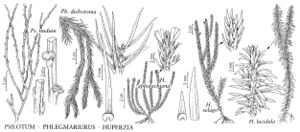Lycopodiaceae
Plants terrestrial, on rock, or epiphytic. Roots emerging near origin, or growing through cortex and emergent some distance from origin. Horizontal stems present or absent, mainly protostelic, in some species becoming actino or plectostelic, on substrate surface or subterranean, or forming stolons. Upright shoots simple or branched, usually conspicuously leafy at least at base; abscising gemmae formed by reduced lateral shoots. Lateral shoots present or absent, simple or branched, branching pattern dichotomous and sometimes pseudomonopodial; leaves uniform or dimorphic or trimorphic. Upright and lateral shoots round or flat in cross-section; leaves on subterranean parts flat, appressed, nonphotosynthetic, and scalelike; leaves on aerial parts appressed, ascending, or spreading, with 1 central unbranched vein, needlelike to lanceolate to ovate, remote to dense and imbricate, with or without basal and/or mucilage canals. Strobili sessile or stalked, upright, nodding, or pendent. Sporangia solitary, adaxial near leaf base or axillary; subtending leaves (sporophylls) unmodified and photosynthetic to much modified, nonphotosynthetic, reduced, and aggregated in strobili; sporangia reniform to globose, thick-walled with hundreds of spores, outer walls variously modified. Spores all 1 kind, trilete, thick-walled, surfaces pitted to small-grooved, rugulate, or reticulate. Gametophytes subterranean and nonphotosynthetic or surficial and photosynthetic.
Distribution
Worldwide
Discussion
The Lycopodiaceae are an extremely diverse, ancient family. The family may contain even more than the estimated 400 species because the tropical members and the very large genus Phlegmariurus are still poorly known. The relationships among genera of Lycopodiaceae are not well understood because large evolutionary gaps exist among most genera. Some of the genera, notably Diphasiastrum, Huperzia, and Lycopodiella, exhibit extensive interspecific hybridization, which has caused much taxonomic confusion in the past. Differences in expressions of many of the generic characters are subtle, and some of the characters are microscopic.
Genera 10–15, species 350–400 (7 genera, 27 species in the flora).
Selected References
Lower Taxa
Illustrations
Key
| 1 | Horizontal stems absent; upright parts of shoots clustered; roots traveling in stem cortex some distance before emerging; sporangia borne in axils of unmodified leaves; spores pitted to small-grooved. | > 2 |
| 1 | Horizontal stems present; upright shoot systems alternating along rhizome; roots emerging from where they originate; sporangia borne in axils of highly modified, reduced sporophylls aggregated into upright or nodding or pendent strobili; spores reticulate or rugulate. | > 3 |
| 2 | Leafy gemmae and gemmiferous branchlets absent; spore sides at equator convex with acute to blunt angles; mainly tropical, epiphytic. | Phlegmariurus |
| 2 | Leafy gemmae and gemmiferous branchlets present; spore sides at equator concave with truncate angles; mainly temperate and subarctic, terrestrial or on rock. | Huperzia |
| 3 | Strobili borne on distinct peduncles or sessile; peduncles, if present, bearing remote, reduced leaves; spores reticulate; gametophytes subterranean, nonphotosynthetic; mainly dry uplands. | > 4 |
| 3 | Strobili erect on leafy peduncles (or nonleafy peduncles in Pseudolycopodiella) or nodding or pendent on lateral shoots; peduncles, if present, bearing closely spaced, unreduced leaves; spores rugulate; gametophytes on substrate surface, photosynthetic; mainly wetlands. | > 5 |
| 4 | Ultimate shoots (including leaves) 5–12 mm diam.; rounded (flattened in Lycopodium obscurum); leaves 6-ranked or more, not imbricate; peduncles, if present, falsely appearing to have 1 main branch (pseudomonopodial) and alternate; gametophytes disc-shaped. | Lycopodium |
| 4 | Ultimate shoots (including leaves) 2–6 mm diam., quadrate to flattened (except in D. sitchense, which is round-branched); leaves mostly 4–5-ranked, mostly imbricate (except in D. sitchense); peduncles, if present, dichotomously branched; gametophytes carrot-shaped. | Diphasiastrum |
| 5 | Upright shoots many branched; leaves linear to needlelike; strobili nodding or pendent at lateral shoot tips. | Palhinhaea |
| 5 | Upright shoots not branched; leaves linear-lanceolate to lanceolate; strobili erect on upright shoots. | > 6 |
| 6 | Peduncles nearly bare, with few, scattered, scalelike leaves; sporophylls shorter than leaves of peduncles; horizontal stems with lateral leaves larger than median leaves and lying flat on substrate. | Pseudolycopodiella |
| 6 | Peduncles leafy with crowded unmodified leaves; sporophylls equaling or longer than leaves of peduncles; horizontal stems with leaves monomorphic, supine or arching. | Lycopodiella |






